1963 Atlantic hurricane season
The 1963 Atlantic hurricane season featured one of the deadliest tropical cyclones on record in the Atlantic basin: Hurricane Flora. The season officially began on June 15, and lasted until November 15. These dates conventionally delimit the period of each year when most tropical cyclones form in the Atlantic basin. It was a near-average season in terms of tropical storms, with a total of nine named storms. The first system, Hurricane Arlene, developed between Cape Verde and the Lesser Antilles on July 31. The storm later impacted Bermuda, where strong winds resulted in about $300,000 (1963 USD) in damage. Other storms such as hurricanes Beulah and Debra, as well as an unnamed tropical storm, did not impact land. During the month of September, Tropical Storm Cindy caused wind damage and flooding in Texas, leaving three deaths and approximately $12.5 million in damage. Hurricane Edith passed through the Lesser Antilles and the eastern Greater Antilles, causing 10 deaths and about $43 million in damage, most of which occurred on Martinique.
| 1963 Atlantic hurricane season | |
|---|---|
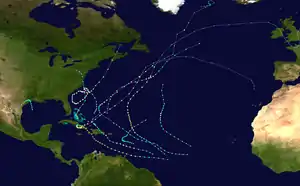 Season summary map | |
| Seasonal boundaries | |
| First system formed | June 1, 1963 |
| Last system dissipated | October 30, 1963 |
| Strongest storm | |
| Name | Flora |
| • Maximum winds | 150 mph (240 km/h) (1-minute sustained) |
| • Lowest pressure | 933 mbar (hPa; 27.55 inHg) |
| Seasonal statistics | |
| Total depressions | 11 |
| Total storms | 10 |
| Hurricanes | 7 |
| Major hurricanes (Cat. 3+) | 3 |
| Total fatalities | 7,214 |
| Total damage | $833.8 million (1963 USD) |
| Related articles | |
The most significant storm of the season was Hurricane Flora, which peaked as a Category 4 hurricane on the Saffir–Simpson hurricane wind scale. Drifting slowly and executing a cyclonic loop, Flora dropped very heavy rainfall in the Greater Antilles, including over 100 in (2,500 mm) in Cuba. Extreme flooding ensued, leaving behind at least 7,193 fatalities and about $773.4 million in damage. Flora is thus listed among the deadliest Atlantic hurricanes on record. In October, Hurricane Ginny moved erratically offshore the Southeastern United States, though eventually, the extratropical remnants struck Nova Scotia. Ginny caused at least three deaths and $400,000 in damage in the United States alone. The final cyclone, Tropical Storm Helena, caused five deaths and over $500,000 in damage on Guadeloupe. Overall, the storms in this season caused at least 7,214 deaths and about $830.1 million in damage.
Season summary


The 1963 hurricane season officially began on June 15 and ended on November 15.[1] It was a near-average with nine tropical storms,[2] slightly less than the 1950–2000 average of 9.6 named storms.[3] Seven of these reached hurricane status,[2] which is above the 1950–2000 average of 5.9.[3] Furthermore, two storms reached major hurricane status,[2] which is Category 3 or higher on the Saffir–Simpson hurricane wind scale.[4] Early in the season, activity was suppressed by an abnormally intense trough offshore the East Coast of the United States as well as strong westerly winds. Later, tropical cyclone formation occurred more often after a portion of the trough weaken and easterly flow increased across much of the Atlantic.[5] A total of four hurricanes made landfall during the season,[2] causing at least 7,214 deaths and $830.1 million in damage. Hurricane Ginny and Tropical Storm Helena also caused damage and deaths, despite remaining offshore and then after becoming extratropical.[5][6]
Tropical cyclogenesis began late, with Hurricane Arlene developing on July 31. Another system formed in August, Hurricane Beulah. September was much more active, with an unnamed tropical storm, as well as hurricanes Cindy, Debra, Edith, and Flora all developing in that month. Flora was the most intense tropical cyclone of the season, peaking as a Category 4 hurricane with winds of 145 mph (230 km/h) and a minimum barometric pressure of 940 mbar (27.76 inHg). There were two other system in October, Hurricane Ginny and Tropical Storm Helena; the latter dissipated on October 29.[2]
The season's activity was reflected with an above average accumulated cyclone energy (ACE) rating of 118.[3][4] ACE is, broadly speaking, a measure of the power of the hurricane multiplied by the length of time it existed, so storms that last a long time, as well as particularly strong hurricanes, have high ACEs. It is only calculated for full advisories on tropical systems at or exceeding 39 mph (63 km/h), which is tropical storm strength. Subtropical cyclones are excluded from the total.[7]
Systems
Tropical Storm One
| Tropical storm (SSHWS) | |
  | |
| Duration | June 1 – June 4 |
|---|---|
| Peak intensity | 60 mph (95 km/h) (1-min) 1000 mbar (hPa) |
Toward the end of May, a tropical disturbance moved northward from Panama toward the western Caribbean Sea. On May 31, a trough moved across eastern Cuba. The disturbance dropped heavy rainfall across Cuba, reaching 8.50 in (216 mm) in Santiago de Cuba. On June 1, a tropical depression developed over the western Bahamas. Initially, the depression could have been a subtropical cyclone, due to an upper-level low located over the circulation. The depression moved to the northeast and later to the north, strengthening into a tropical storm on June 2. A day later, the storm attained peak winds of 60 mph (95 km/h); on the same day, the storm made landfall just west of Cape Hatteras, North Carolina. By June 4, the storm weakened to a tropical depression as it continued northwestward through Virginia, Maryland, and finally Pennsylvania, where the depression degenerated into a trough.[8]
The storm produced gusty winds along the eastern United States coast, from North Carolina through Maryland. Winds reached 40 mph (65 km/h) in Ocean City, Maryland and 39 mph (64 km/h) in Norfolk, Virginia. The latter city recorded 6.87 in (174 mm) of rainfall in a 24-hour period, setting a daily rainfall record for the location.[8] Heavy rainfall reached as far north as Washington, D.C.[9]
Hurricane Arlene
| Category 3 hurricane (SSHWS) | |
 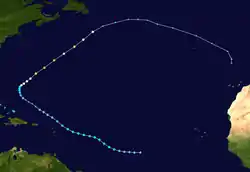 | |
| Duration | July 31 – August 11 |
|---|---|
| Peak intensity | 115 mph (185 km/h) (1-min) 969 mbar (hPa) |
A cloud mass developed into the first tropical depression of the season at 18:00 UTC on July 31 while located about halfway between the Lesser Antilles and Cape Verde.[2][5] It headed west, becoming a tropical storm on August 2. Arlene soon rapidly intensified, acquiring 100 mph (155 km/h) maximum sustained winds–ranking it as a Category 2 hurricane–later that day.[2] However, lack of outflow caused it to weaken to a tropical depression by August 4.[5] The storm failed to significantly reorganize until August 7, by which time it restrengthened into a tropical storm. The following day, Arlene re-intensified into a hurricane before passing directly over Bermuda. Several hours after passing the island, the hurricane reached its peak intensity with winds of 105 mph (165 km/h) and a barometric pressure of 969 mbar (28.6 inHg). On August 11, Arlene transitioned into an extratropical cyclone before being absorbed by another cyclone later that day.[2][5]
Along its track, several hurricane warnings and watches were issued for the Leeward Islands;[10] however, no damage was reported on any of the islands.[5] The storm has its greatest impact in Bermuda, where high winds and near-record rainfall of 6.05 inches (154 mm) downed trees, power lines, and caused flooding.[5][11][12] Damages across the island amounted to $300,000 (1963 USD).[5]
Hurricane Beulah
| Category 3 hurricane (SSHWS) | |
 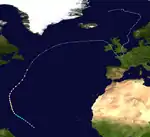 | |
| Duration | August 20 – August 27 |
|---|---|
| Peak intensity | 120 mph (195 km/h) (1-min) 958 mbar (hPa) |
On August 20, a tropical wave developed into a tropical depression while situated about 635 mi (1,020 km) north-northwest of Cayenne, French Guiana.[2][5] Moving west-northwestward, the depression strengthened into Tropical Storm Beulah around 06:00 UTC on the following day.[2] Later on August 21, the first reconnaissance aircraft flight into the storm observed winds of 52 mph (84 km/h) and a barometric pressure of 1,005 mbar (29.68 inHg). A subsequent flight into Beulah on August 22 recorded a well-defined eye, winds of 78 mph (126 km/h), and a barometric pressure of 994 mbar (29.35 inHg).[5] As a result, the storm was upgraded to a Category 1 hurricane around 12:00 UTC. Shortly thereafter, Beulah curved north-northwestward and continued to deepen. Early on August 23, it strengthened into a Category 2 hurricane.[2]
The storm intensified into a Category 3 hurricane by early on August 24, at which time Beulah attained its peak intensity with maximum sustained winds of 120 mph (195 km/h) and a minimum barometric pressure of 958 mbar (28.29 inHg).[2] Radar imagery depicted an elliptical eye with a diameter of 20 to 30 mi (32 to 48 km).[5] The hurricane turned to the north, where an anticyclone that was favoring development to its south caused unfavorable conditions.[2] Beulah weakened to a minimal hurricane, but briefly re-intensified into a Category 2 hurricane before racing to the northeast under the influence of an upper-level trough offshore the East Coast of the United States.[5] Early on August 28, the hurricane transitioned into an extratropical cyclone about 250 mi (400 km) east of Newfoundland.[2]
Hurricane Four
| Category 1 hurricane (SSHWS) | |
  | |
| Duration | September 9 – September 14 |
|---|---|
| Peak intensity | 80 mph (130 km/h) (1-min) 990 mbar (hPa) |
As early as September 8, ships north of Puerto Rico reported a weak circulation. Drifting northward,[5] the system developed tropical depression by 06:00 UTC on September 10, while situated about 150 mi (240 km) southwest of Bermuda.[2] The cyclone was subtropical in nature, fueled by both latent heat and instability from contrasting cool and warm air masses. While passing Bermuda later on September 10, sustained wind speeds of 25 mph (40 km/h) and decrease in barometric pressure were observed.[5] The system moved east-northeastward and strengthened into a tropical storm early the following day. By late on September 12, the storm attained its peak intensity with maximum winds of 60 mph (95 km/h) and a minimum barometric pressure of 992 mbar (29.29 inHg).[2] Around that time, the Freiburg observed winds of 78 mph (126 km/h).[5] Thereafter, the system accelerated ahead of a cold front and became extratropical on September 14, while located about 725 mi (1,167 km) north-northwest of Corvo Island in the Azores. The extratropical remnants moved rapidly eastward, until dissipating well west of Ireland early on September 15.[2]
Tropical Storm Cindy
| Tropical storm (SSHWS) | |
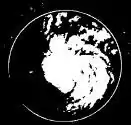 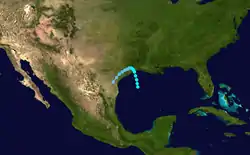 | |
| Duration | September 16 – September 20 |
|---|---|
| Peak intensity | 65 mph (100 km/h) (1-min) 996 mbar (hPa) |
In mid-September, a trough of low pressure was situated in the Gulf of Mexico.[5] The system developed into Tropical Storm Cindy at 12:00 UTC on September 16, while located about 210 mi (340 km) south of Cameron, Louisiana. Cindy strengthened while moving north-northwestward. Around that time, the storm attained its peak intensity with maximum winds of 65 mph (130 km/h) and a minimum pressure of 996 mbar (29.41 inHg). Shortly after 12:00 UTC on September 17, Cindy made landfall near High Island, Texas at its that intensity. After landfall, Cindy weakened to a tropical depression within about 18 hours. Turning southwest, the depression dissipated at 00:00 UTC on September 20.[2]
In southwestern Louisiana, over 15 in (380 mm) of rain fell in some areas. Rice crops were flooded, causing about $360,000 in damage. However, the precipitation was described as more beneficial than detrimental.[5] Along the coast, tides inundated roads leading to Cameron and Holly Beach.[13] A man drowned offshore Cameron while evacuating from an oil rig. The storm brought flooding to the southeastern Texas, particularly in and around Port Arthur. Two people drowned in the Port Acres area. Water entered 4,000 homes across Jefferson, Newton, and Orange counties.[5] In Oklahoma, flooding in Guthrie prompted 300 residents to flee their homes; water intruded into 25 businesses and 35 homes.[14] Overall, Cindy caused about $12.5 million in damage, of which $11.7 million stemmed from property damage.[5]
Hurricane Debra
| Category 1 hurricane (SSHWS) | |
  | |
| Duration | September 19 – September 24 |
|---|---|
| Peak intensity | 75 mph (120 km/h) (1-min) 999 mbar (hPa) |
On September 19, a westward moving tropical wave became a tropical depression about 900 mi (1,400 km) east of the southwesternmost islands of Cape Verde.[2][5] Initially, the depression moved west-northwestward and remained weak. Despite the system's intensity at the time, a reconnaissance aircraft flight observed a radar eye on September 20. While curving northward early on September 21, the depression intensified into Tropical Storm Debra. Several hours later, Debra became a Category 1 hurricane. The cyclone peaked with maximum sustained winds of 75 mph (120 km/h) and a minimum barometric pressure of 999 mbar (29.50 inHg) late on September 22. Debra soon began weakening and fell to tropical storm status early the following day.[2] The system began losing tropical characteristics and was absorbed by an extratropical low late on September 24,[5] while located about halfway between Bermuda and Flores Island in the Azores.[2]
Hurricane Edith
| Category 2 hurricane (SSHWS) | |
 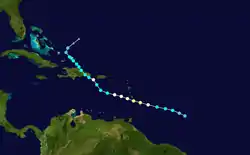 | |
| Duration | September 23 – September 29 |
|---|---|
| Peak intensity | 100 mph (155 km/h) (1-min) 990 mbar (hPa) |
An Intertropical Convergence Zone (ITCZ) disturbance developed into a tropical depression while east of the Windward Islands on September 23.[15] The depression strengthened into Tropical Storm Edith the next day. Only six hours later, Edith reached hurricane status. Edith fluctuated between Category 1 and 2 status as it moved west-northwest.[5] After striking Saint Lucia on September 25, the storm traversed the eastern Caribbean Sea. Curving north-northwest on September 26, Edith made landfall near La Romana, Dominican Republic, early on the following day as a minimal hurricane. Interaction with land and an upper-level trough caused Edith to weaken to a tropical storm on September 28 and to a tropical depression by the next day. The storm dissipated just east of the Bahamas on September 29.[2]
In Martinique, a wind gust of 127 mph (204 km/h) was observed at Le Lamentin Airport; tides about 8 ft (2.4 m) above normal and heavy rainfall impacted the island.[16] Throughout the island, about 6,000 homes were demolished and 13,000 other were severely impacted.[15] Agriculture suffered significantly, with bananas and other food crops destroyed, while sugar cane experienced significant damage.[17] Winds up to 80 mph (130 km/h) caused significant damage on Dominica and strong winds on Saint Lucia ruined about half of the island's banana crop.[5] In Puerto Rico, the storm brought heavy rainfall to the southwest corner of the island and abnormally high tides to the south coast. Several beach front properties were badly damaged, particularly in the Salinas municipality.[18] Overall, Edith caused 10 deaths, all on Martinique, and approximately $46.6 million in damage.[5]
Hurricane Flora
| Category 4 hurricane (SSHWS) | |
 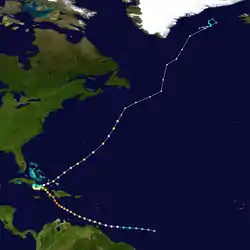 | |
| Duration | September 28 – October 11 |
|---|---|
| Peak intensity | 150 mph (240 km/h) (1-min) 933 mbar (hPa) |
On September 26, another tropical depression developed from the ITCZ about 755 mi (1,215 km) southwest of the Cape Verde Islands.[2][5] After remaining weak for several days, it rapidly organized on September 29 into Tropical Storm Flora. Quickly strengthening, Flora passed over Tobago on September 30 with winds of 120 mph (190 km/h). Curving west-northwestward, Flora peaked as a Category 4 hurricane with winds of 145 mph (230 km/h) on October 3. Early the next day, the hurricane made landfall in southwestern Haiti at the same intensity. Flora briefly re-emerged into the Caribbean Sea on October 4, where the storm weakened to a Category 3. Late on October 4, the cyclone made landfall near San Antonio del Sur, Cuba, with winds of 125 mph (200 km/h). A ridge to the north caused Flora to stall and move erratically over eastern Cuba for four days, and Flora eventually emerged into the Atlantic Ocean on October 8 as a weakened storm. After passing over the southeastern Bahamas early on October 9, Flora began to restrengthen and became a major hurricane again on the next day. Thereafter, Flora continued northeastward and gradually weakened, falling to Category 1 intensity on October 11. Flora gradually lost convection and became extratropical on October 12 while located 270 mi (430 km) east-southeast of Cape Race, Newfoundland. The extratropical remnants dissipated the next day.[2]
In Trinidad and Tobago, abnormally high tides capsized six ships in Scarborough harbor,[19] while strong winds caused severe effects to coconut, banana, and cocoa plantations, with 50% of the coconut trees destroyed and 11% severely damaged. About 2,750 houses were destroyed, while 3,500 others were impacted. The hurricane killed 24 people and resulted in $30.1 million damage.[20] Six additional drowning fatalities occurred in Grenada. The slow movement of the storm resulted in record rainfall totals for the Greater Antilles. In Dominican Republic, over 3,800 sq mi (9,800 km2) of land was flooded. Bridges and roads were significantly damaged, with many roads left unpassable for several months. The hurricane caused about $60 million in damage and over 400 deaths.[5] In Haiti, flash floods washed out large sections of several towns, while mudslides buried some entire cities.[21] In most areas, crops were entirely destroyed.[5] Additionally, the combination of rough waves and strong winds destroyed three entire communities.[21] About 3,500 people were confirmed dead and damaged ranged $125 million and $180 million.[5] In Cuba, the storm dropped 100.39 in (2,550 mm) of rainfall at Santiago de Cuba.[22] Nearly all crops in southeastern Cuba were affected by strong winds and flooding. Many citizens were left stranded at the tops of their houses. Several entire houses were swept away by the flooding, and many roads and bridges were destroyed, resulting in major disruptions to communications.[23] Throughout the country, the hurricane destroyed as many as 30,000 dwellings.[6] Flora left at least 1,750 fatalities and $500 million in damage in Cuba.[5][6] Overall, Hurricane Flora caused at least 7,193 deaths and over $783.4 million in damage.[5][6]
Hurricane Ginny
| Category 2 hurricane (SSHWS) | |
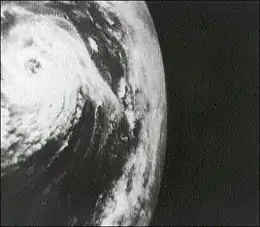 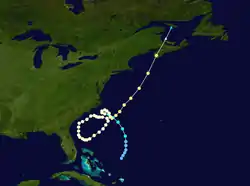 | |
| Duration | October 17 – October 29 |
|---|---|
| Peak intensity | 110 mph (175 km/h) (1-min) 948 mbar (hPa) |
On October 16, a tropical depression formed near Turks and Caicos from the interaction of a trough and a tropical wave, although the system was not very tropical due to cold air.[5][24] It moved to the north and northwest, becoming Tropical Storm Ginny on October 19. The next day it attained hurricane status,[2] and approached North Carolina before looping to the southwest due to a ridge over New England. By October 22, Ginny crossed the Gulf Stream and intensified, developing an eye. It briefly weakened to a tropical storm the next day while approaching Florida, but regained hurricane intensity within ten hours.[5][24] Ahead of an advancing trough,[25] Ginny turned sharply northward and later northeastward, paralleling the coast of the Southeastern United States. For eight days, the storm was within 250 mi (400 km) of the United States coastline. Moving farther offshore, Ginny gradually intensified to reach peak winds of 110 mph (175 km/h) on October 29.[5][24] Later that day, it became extratropical before striking southwestern Nova Scotia; its remnants dissipated on October 30 over the Gulf of Saint Lawrence.[2]
Early in its existence, Ginny dropped heavy rainfall across the Dominican Republic and the Bahamas.[11] In Florida and Georgia, Ginny produced above normal tides that caused minor damage and beach erosion.[5] Rainfall was beneficial in South Carolina,[26] and in North Carolina, high tides caused minor flooding and destroyed one house.[27] In Massachusetts, wind gusts reached 76 mph (122 km/h) in Nantucket,[5] and 1,000 homes lost power in Chatham.[28] Ginny was the latest hurricane on record to affect Maine during a calendar year.[29] During its passage, the storm brought an influx of cold air that produced up to 4 ft (1.2 m) of snow in northern Maine, killing two people. Offshore, many boats were damaged or ripped from their moorings; one person died from a heart attack while trying to rescue his boat.[28] Damage from Ginny in the United States was estimated at $400,000.[5] In Canada, high winds downed trees and caused power outages, leaving the entirety of Prince Edward Island without power.[30]
Tropical Storm Helena
| Tropical storm (SSHWS) | |
 | |
| Duration | October 25 – October 30 |
|---|---|
| Peak intensity | 50 mph (85 km/h) (1-min) 1002 mbar (hPa) |
A tropical wave accompanied by a large area of convection moved westward in late October. On October 25, the wave spawned a tropical depression, based on ship and Hurricane Hunter reports of southwest winds and heavy rainfall. Although poorly defined, the system gradually intensified and became Tropical Storm Helena.[5] On October 26, the storm reached peak winds of 50 mph (85 km/h),[2] before quickly weakening when it passed between Dominica and Guadeloupe, potentially due to their high terrain.[5] Helena was a weak tropical depression upon entering the eastern Caribbean Sea, but re-intensified into a tropical storm after turning to the north on October 27.[2] Its slow, erratic movement and failure to intensify was due to a weak trough across the region. While passing near Antigua, the storm developed an intense rainband that produced winds of 58 mph (93 km/h), as measured by reconnaissance aircraft between Dominica and Guadeloupe. However, Helena again weakened into a tropical depression on October 29 and dissipated shortly thereafter.[5]
The threat of Helena prompted the San Juan Weather Bureau to issue a hurricane watch and later gale warnings for portions of the Lesser Antilles.[31] On the Guadeloupe, the storm left 500 people homeless, killed 5 people, and seriously injured 14 others. Several boats were heavily damaged or sank. Damage was estimated at $500,000.[5]
Storm names
The following names were used for named storms (tropical storms and hurricanes) that formed in the North Atlantic in 1963.[1] Storms were named Ginny and Helena for the first time in 1963. The name Flora was later retired.[32] Names that were not assigned are marked in gray.
|
|
Season effects
The following table lists all of the storms that have formed in the 1963 Atlantic hurricane season. It includes their duration, names, landfall(s) (in parentheses), damages, and death totals. Deaths in parentheses are additional and indirect (an example of an indirect death would be a traffic accident), but were still related to that storm. Damage and deaths include totals while the storm was extratropical, a wave, or a low, and all of the damage figures are in 1963 USD.
| Saffir–Simpson scale | ||||||
| TD | TS | C1 | C2 | C3 | C4 | C5 |
| Storm name |
Dates active | Storm category
at peak intensity |
Max 1-min wind mph (km/h) |
Min. press. (mbar) |
Areas affected | Damage (USD) |
Deaths | Refs | ||
|---|---|---|---|---|---|---|---|---|---|---|
| One | June 1 – 4 | Tropical storm | 60 (95) | 1000 | The Bahamas, North Carolina, Mid-Atlantic | Unknown | None | |||
| Arlene | July 31 – August 11 | Category 3 hurricane | 115 (185) | 969 | Lesser Antilles, Bermuda | $300,000 | None | |||
| Beulah | August 20 – 27 | Category 3 hurricane | 120 (195) | 958 | British Isles, France | None | None | |||
| Four | September 9 – 14 | Category 1 hurricane | 80 (140) | 990 | Bermuda | None | None | |||
| Cindy | September 16 – 20 | Tropical storm | 65 (100) | 996 | Texas, Louisiana | $12.5 million | 3 | |||
| Debra | September 19 – 24 | Category 1 hurricane | 75 (120) | 999 | None | None | None | |||
| Edith | September 23 – 29 | Category 2 hurricane | 100 (155) | 990 | Lesser Antilles, Puerto Rico, Hispaniola, Turks and Caicos Islands, Bahamas | $46.6 million | 10 | |||
| Flora | September 28 – October 11 | Category 4 hurricane | 150 (240) | 933 | Lesser Antilles, Leeward Antilles, Venezuela, Puerto Rico, Hispaniola, Jamaica, Cuba, Bahamas, Turks and Caicos Islands, Bermuda, Atlantic Canada | $773.4 million | 7,193 | |||
| Ginny | October 17 – 29 | Category 2 hurricane | 110 (175) | 948 | Hispaniola, Turks and Caicos Islands, Bahamas, East Coast of the United States, Atlantic Canada | $500,000 | 3 | |||
| Helena | October 25 – 30 | Tropical storm | 50 (85) | 1002 | Lesser Antilles | $500,000 | 5 | |||
| Season aggregates | ||||||||||
| 10 systems | June 1 – October 30 | 150 (240) | 933 | $833.8 million | 7,214 | |||||
See also
- 1963 Pacific hurricane season
- 1963 Pacific typhoon season
- 1963 North Indian Ocean cyclone season
- List of Atlantic hurricanes
- Atlantic hurricane season
References
- "21 Stormy Ladies". The Age. Washington, D.C. Associated Press and Reuters. June 6, 1963. p. 3. Retrieved June 27, 2014.
- "Atlantic hurricane best track (HURDAT version 2)" (Database). United States National Hurricane Center. May 25, 2020.
- Philip J. Klotzbach; William M. Gray (December 8, 2006). Extended Range Forecast of Atlantic Seasonal Hurricane Activity and U.S. Landfall Strike Probability for 2007 (Report). Boulder, Colorado: Colorado State University. Archived from the original on 18 December 2006. Retrieved March 28, 2014.
- Atlantic basin Comparison of Original and Revised HURDAT. Hurricane Research Division; Atlantic Oceanographic and Meteorological Laboratory (Report). National Oceanic and Atmospheric Administration. March 2011. Retrieved March 6, 2012.
- Gordon E. Dunn (March 1964). "The Hurricane Season of 1963" (PDF). Monthly Weather Review. Miami, Florida: United States Weather Bureau. 92 (3): 128–138. doi:10.1175/1520-0493(1964)092<0128:thso>2.3.co;2. Retrieved June 29, 2014.
- Louis A. Pérez (October 1, 2014). Cuba: Between Reform and Revolution. New York City, New York: Oxford University Press. p. 6. ISBN 978-0199301447. Retrieved November 27, 2015.
- David Levinson (August 20, 2008). 2005 Atlantic Ocean Tropical Cyclones. National Climatic Data Center (Report). National Oceanic and Atmospheric Administration. Archived from the original on December 1, 2005. Retrieved March 6, 2012.
- https://www.aoml.noaa.gov/hrd/hurdat/metadata-1961-1965.pdf
- ftp://ftp.library.noaa.gov/docs.lib/htdocs/rescue/mwr/091/mwr-091-09-0468.pdf
- Walter R. Davis (August 4, 1963). San Juan Weather Bureau Bulletin for Press, Radio, and Television 9 PM AST August 3, 1963 (Report). San Juan, Puerto Rico: Weather Bureau. Retrieved November 16, 2015.
- Roth, David M. (October 18, 2017). "Tropical Cyclone Point Maxima". Tropical Cyclone Rainfall Data. United States Weather Prediction Center. Retrieved November 26, 2017.
- "Arlene moves out to sea after hitting Bermuda". The Bend Bulletin. Hamilton, Bermuda. United Press International. August 10, 1963. Retrieved November 16, 2015.
- E. J. Saltsman (October 16, 1963). Final report – Hurricane "Cindy", September 16–20, 1963. Weather Bureau Office, New Orleans, Louisiana (Report). New Orleans, Louisiana: National Oceanic and Atmospheric Administration; National Hurricane Center. p. 3. Retrieved July 2, 2014.
- Stanley G. Holbrok (September 26, 1963). Tropical Cyclone Reports. Weather Bureau Office, Oklahoma City, Oklahoma (Report). Oklahoma City, Oklahoma: National Oceanic and Atmospheric Administration; National Hurricane Center. Retrieved July 2, 2014.
- Hurricane Edith, September 23-28, 1963, preliminary report with advisories and bulletins issued (PDF) (Report). United States Weather Bureau. December 2, 1963. p. 1. Retrieved November 17, 2015.
- M. Perrusset (October 2, 1963). Martinique (Report). Fort-de-France: United States Weather Bureau. Retrieved November 17, 2015.
- M. Perrusset (October 2, 1963). Observations Des Stations Meteorologiques (Report) (in French). Fort-de-France: United States Weather Bureau. Service Météorologique du groupe Antilles-Guyane. Retrieved November 17, 2015.
- The Affects of Hurricane "Edith" to Puerto Rico and Virgin Islands September 26-27, 1963. United States Weather Bureau (Report). National Oceanic and Atmospheric Administration; National Hurricane Center. Retrieved August 21, 2013.
- John D. Lee (1963). Trinidad and Tobago Effects (Report). Trinidad and Tobago Meteorological Service. Retrieved November 17, 2015.
- C. B. Daniel; R. Maharaj; G. De Souza (2002). Tropical Cyclones Affecting Trinidad and Tobago, 1725 to 2000 (PDF) (Report). Trinidad and Tobago Meteorological Service. Archived from the original (PDF) on May 23, 2005. Retrieved November 28, 2006.
- Ralph L. Higgins (1963). Hurricane Flora Subsequent Report to the Dominican Republic and Haiti Page 4 (Report). San Juan, Puerto Rico: Weather Bureau Office San Juan, Puerto Rico. Retrieved November 27, 2015.
- Lluvias intensas observadas y grandes inundaciones reportadas (Report) (in Spanish). Instituto Nacional de Recursos Hidráulicos. 2003. Archived from the original on November 5, 2013. Retrieved February 10, 2007.
- José Fernández Partagás (October 10, 1963). Information from Cuba (Report). Miami, Florida: National Hurricane Center. Retrieved November 29, 2006.
- Lewis J. Allison; Harold P. Thompson (June 1966). TIROS VII Infrared Radiation Coverage of the 1963 Atlantic Hurricane Season With Supporting Television and Conventional Meteorological Data (PDF) (Report). NASA. Retrieved 2011-10-16.
- P.L. Moore (1963-10-28). Ginny Advisory Number 31 (GIF) (Report). National Hurricane Center. Retrieved 2011-10-16.
- Nathan Kronberg, Columbia, S.C. Weather Bureau Air Station (1963-10-30). "Preliminary Report on Hurricane Ginny in South Carolina" (GIF). National Hurricane Center. Retrieved 2011-10-16.
- Wilmington, N.C. Weather Bureau Office (1963-10-28). "Preliminary Report on Hurricane Ginny October 19 to 27 1963". National Hurricane Center. Retrieved 2011-10-17.
- Robert E. Lautzenhaiser, Boston Massachusetts Weather Bureau State Climatologist (1963-11-18). "Tropical Cyclone Reports — Hurricane Ginny" (GIF). National Hurricane Center. Retrieved 2011-10-17.
- Wayne Cotterly (1996). "Hurricanes and Tropical Storms; Their Impact on Maine and Androscoggin County" (PDF). Archived from the original (PDF) on 2016-04-01. Retrieved 2011-10-17.
- Canadian Hurricane Centre (2010-09-14). "1963-Ginny". Retrieved 2011-10-17.
- Harry M. Hoose (1963-11-01). Tropical Storm Helena, October 25-29, 1963 (GIF) (Report). San Juan Weather Bureau. Retrieved 2013-04-24.
- Tropical Cyclone Naming History and Retired Names. National Hurricane Center (Report). Miami, Florida: National Oceanic and Atmospheric Administration. 2015. Retrieved November 27, 2015.